|
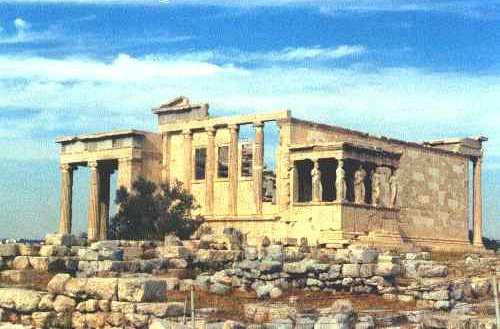 When arriving in
Athens on a Lufthansa flight in September 1995, the smog hung over the
city like a big cloud. But you could make out the Acropolis. The airport
was right at the sea so the view was fantastic. After our arrival we took a
bus into the city centre and went to look for a cheap hotel. The hotel
was so cheap that nobody could speak English and the bed was far too soft
so the night was absolutely terrible. In the afternoon we had visited the
Acropolis which offers a great view over the city (entrance fee 1000 drachmas)
and the old town called Pláka. When arriving in
Athens on a Lufthansa flight in September 1995, the smog hung over the
city like a big cloud. But you could make out the Acropolis. The airport
was right at the sea so the view was fantastic. After our arrival we took a
bus into the city centre and went to look for a cheap hotel. The hotel
was so cheap that nobody could speak English and the bed was far too soft
so the night was absolutely terrible. In the afternoon we had visited the
Acropolis which offers a great view over the city (entrance fee 1000 drachmas)
and the old town called Pláka.
On Tuesday, 5th September,
we took a taxi to the car rental agency which wasn't so easy to find. We
had booked a car from Germany for one week. Finally we set off north towards
the famous Metéora monasteries. Driving in the chaotic traffic of
Athens was horror, so we were relieved when we got out of the city. It
was a long drive up to Tríkala and Kalambáka (about
5 hours)
and we spent the night at the camp site of Metéora.
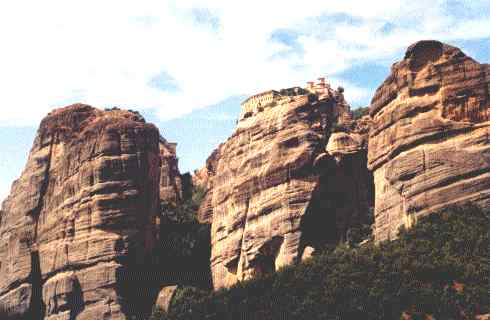 The following morning
we almost didn't get to see the monasteries as the road of access was blocked
due to a strike! The only way to get up now was to share a taxi with several
people and eventually we managed
to get one. It was a shame we couldn't stop where we wanted as the scenery
was breathtaking. But at least we didn't come in vain. It's amazing how
the monks lived up there as the monasteries are built on top of steep pinnacles
of rock up to 600 m high. There used to be 24 monasteries. Only 7 of them
remain today and 5 are still inhabited. The taxi dropped us off at the
monastery Ágios Stefanos which we visited (entrance fee is 400 drachmas).
Afterwards we started to walk back down but we found someone to take us
along to our car. Then we returned back south towards Delphi which was
quite a long drive again. The camp site 3.5 km from Delphi had a swimming
pool and offered a beautiful view over Itéa bay. The following morning
we almost didn't get to see the monasteries as the road of access was blocked
due to a strike! The only way to get up now was to share a taxi with several
people and eventually we managed
to get one. It was a shame we couldn't stop where we wanted as the scenery
was breathtaking. But at least we didn't come in vain. It's amazing how
the monks lived up there as the monasteries are built on top of steep pinnacles
of rock up to 600 m high. There used to be 24 monasteries. Only 7 of them
remain today and 5 are still inhabited. The taxi dropped us off at the
monastery Ágios Stefanos which we visited (entrance fee is 400 drachmas).
Afterwards we started to walk back down but we found someone to take us
along to our car. Then we returned back south towards Delphi which was
quite a long drive again. The camp site 3.5 km from Delphi had a swimming
pool and offered a beautiful view over Itéa bay.
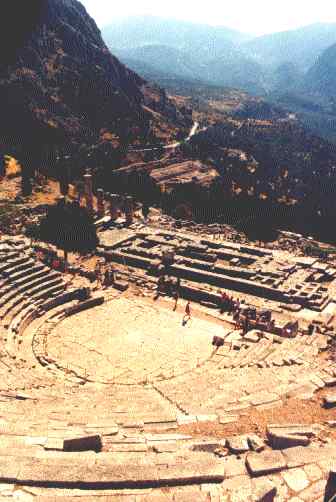 The
archaeological site of Delphi which we visited the following day was very
interesting. People used to come here for its famous oracle. From the amphitheatre
you have a nice view over the valley. We had lunch in the town of Delphi
at a restaurant with a great view over the bay of Itéa where we
enjoyed a quick bath in the sea later on. Then we took the ferry to the
Peloponessos. We spent the night at a camp site near Pátras. The
archaeological site of Delphi which we visited the following day was very
interesting. People used to come here for its famous oracle. From the amphitheatre
you have a nice view over the valley. We had lunch in the town of Delphi
at a restaurant with a great view over the bay of Itéa where we
enjoyed a quick bath in the sea later on. Then we took the ferry to the
Peloponessos. We spent the night at a camp site near Pátras.
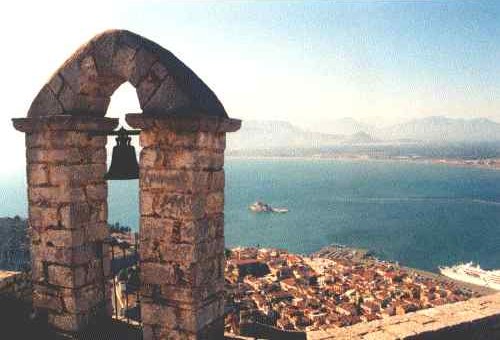 On
Friday, 8th September, we visited the ruins of the ancient fortress Mycanae
and the Treasury of Atreus, a grave resembling a beehive which you can
enter. Finally we arrived in the pretty town of Náfplio, the former
capital, and climbed the 1000 steps up to the fortress Palamídi.
Very tiring in the heat, but the view over the town and out to the sea
was well worth it. The entrance for German students was free. This was
often the case in Greece, or at least there was a discount. All you needed
was an International Student Card. We stayed at the Nicolas II Beach camp
site close to the old part of Epídavros (Paléa Epídavros),
18 km from the ancient theatre. On
Friday, 8th September, we visited the ruins of the ancient fortress Mycanae
and the Treasury of Atreus, a grave resembling a beehive which you can
enter. Finally we arrived in the pretty town of Náfplio, the former
capital, and climbed the 1000 steps up to the fortress Palamídi.
Very tiring in the heat, but the view over the town and out to the sea
was well worth it. The entrance for German students was free. This was
often the case in Greece, or at least there was a discount. All you needed
was an International Student Card. We stayed at the Nicolas II Beach camp
site close to the old part of Epídavros (Paléa Epídavros),
18 km from the ancient theatre.
The
following morning we visited the amphitheatre of Epídavros which
is very well preserved and the town of Paléa Epídavros. In
the afternoon we spent some time at the beach of the camp site. In the
evening we went to a local restaurant right next to the camp site. The
cuisine was superb, not at all touristy and even inexpensive. There was
no menu and the dishes changed every day. To avoid making a mistake we
stuck to something we knew like Moussaka. Besides the restaurant was right
at the sea so you could watch the sunset, very romantic! 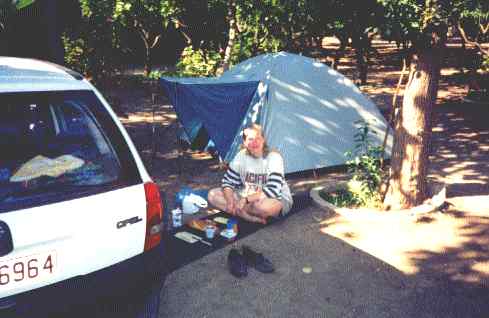
On 10th September
we made a little tour of the coast south of Epídavros down to Ermióni
and spent some time at the beach again.
The day afterwards
we crossed the Isthmus Canal at Corinth which separates the Peloponessos
from the mainland and arrived at Piraeus, the port of Athens. We lost our
way to the centre and were glad to find a Hertz agency where we could leave
the car without trying to make our way back through the horrendous traffic.
For the last two nights we found a cheap hotel in Piraeus which was a bit
better than the first one.
On our last day we
took the ferry (962 drachmas) to the island of Aegina. There we only stayed
in the port town which was quite nice. After our return we visited some
more of Athens (there's a train connection from Pireaus), namely the University
and the Parliament in front of which is the Tomb of the Unknown Soldier
guarded by two Evzones dressed in traditional uniforms.
The weather in September
was still very hot, but not too hot to go visiting. We tried the varieties
of Greek food. Often it was cheaper to take a menu than pay for everything
extra. I was surprised though that the portions were much smaller than
what we are used to at Greek restaurants in Germany which are known for
their abundance. And one curiosity was: you should never throw toilet paper
into the toilet bowl as it will clog the canalisation!
|


 When arriving in
Athens on a Lufthansa flight in September 1995, the smog hung over the
city like a big cloud. But you could make out the Acropolis. The airport
was right at the sea so the view was fantastic. After our arrival we took a
bus into the city centre and went to look for a cheap hotel. The hotel
was so cheap that nobody could speak English and the bed was far too soft
so the night was absolutely terrible. In the afternoon we had visited the
Acropolis which offers a great view over the city (entrance fee 1000 drachmas)
and the old town called Pláka.
When arriving in
Athens on a Lufthansa flight in September 1995, the smog hung over the
city like a big cloud. But you could make out the Acropolis. The airport
was right at the sea so the view was fantastic. After our arrival we took a
bus into the city centre and went to look for a cheap hotel. The hotel
was so cheap that nobody could speak English and the bed was far too soft
so the night was absolutely terrible. In the afternoon we had visited the
Acropolis which offers a great view over the city (entrance fee 1000 drachmas)
and the old town called Pláka.  The following morning
we almost didn't get to see the monasteries as the road of access was blocked
due to a strike! The only way to get up now was to share a taxi with several
people and eventually we managed
to get one. It was a shame we couldn't stop where we wanted as the scenery
was breathtaking. But at least we didn't come in vain. It's amazing how
the monks lived up there as the monasteries are built on top of steep pinnacles
of rock up to 600 m high. There used to be 24 monasteries. Only 7 of them
remain today and 5 are still inhabited. The taxi dropped us off at the
monastery Ágios Stefanos which we visited (entrance fee is 400 drachmas).
Afterwards we started to walk back down but we found someone to take us
along to our car. Then we returned back south towards Delphi which was
quite a long drive again. The camp site 3.5 km from Delphi had a swimming
pool and offered a beautiful view over Itéa bay.
The following morning
we almost didn't get to see the monasteries as the road of access was blocked
due to a strike! The only way to get up now was to share a taxi with several
people and eventually we managed
to get one. It was a shame we couldn't stop where we wanted as the scenery
was breathtaking. But at least we didn't come in vain. It's amazing how
the monks lived up there as the monasteries are built on top of steep pinnacles
of rock up to 600 m high. There used to be 24 monasteries. Only 7 of them
remain today and 5 are still inhabited. The taxi dropped us off at the
monastery Ágios Stefanos which we visited (entrance fee is 400 drachmas).
Afterwards we started to walk back down but we found someone to take us
along to our car. Then we returned back south towards Delphi which was
quite a long drive again. The camp site 3.5 km from Delphi had a swimming
pool and offered a beautiful view over Itéa bay.  The
archaeological site of Delphi which we visited the following day was very
interesting. People used to come here for its famous oracle. From the amphitheatre
you have a nice view over the valley. We had lunch in the town of Delphi
at a restaurant with a great view over the bay of Itéa where we
enjoyed a quick bath in the sea later on. Then we took the ferry to the
Peloponessos. We spent the night at a camp site near Pátras.
The
archaeological site of Delphi which we visited the following day was very
interesting. People used to come here for its famous oracle. From the amphitheatre
you have a nice view over the valley. We had lunch in the town of Delphi
at a restaurant with a great view over the bay of Itéa where we
enjoyed a quick bath in the sea later on. Then we took the ferry to the
Peloponessos. We spent the night at a camp site near Pátras.
 On
Friday, 8th September, we visited the ruins of the ancient fortress Mycanae
and the Treasury of Atreus, a grave resembling a beehive which you can
enter. Finally we arrived in the pretty town of Náfplio, the former
capital, and climbed the 1000 steps up to the fortress Palamídi.
Very tiring in the heat, but the view over the town and out to the sea
was well worth it. The entrance for German students was free. This was
often the case in Greece, or at least there was a discount. All you needed
was an International Student Card. We stayed at the Nicolas II Beach camp
site close to the old part of Epídavros (Paléa Epídavros),
18 km from the ancient theatre.
On
Friday, 8th September, we visited the ruins of the ancient fortress Mycanae
and the Treasury of Atreus, a grave resembling a beehive which you can
enter. Finally we arrived in the pretty town of Náfplio, the former
capital, and climbed the 1000 steps up to the fortress Palamídi.
Very tiring in the heat, but the view over the town and out to the sea
was well worth it. The entrance for German students was free. This was
often the case in Greece, or at least there was a discount. All you needed
was an International Student Card. We stayed at the Nicolas II Beach camp
site close to the old part of Epídavros (Paléa Epídavros),
18 km from the ancient theatre. 